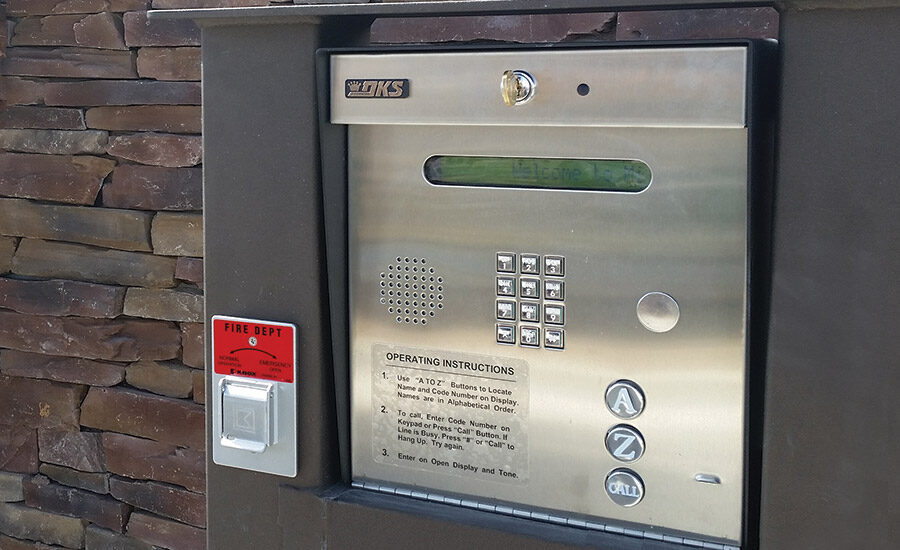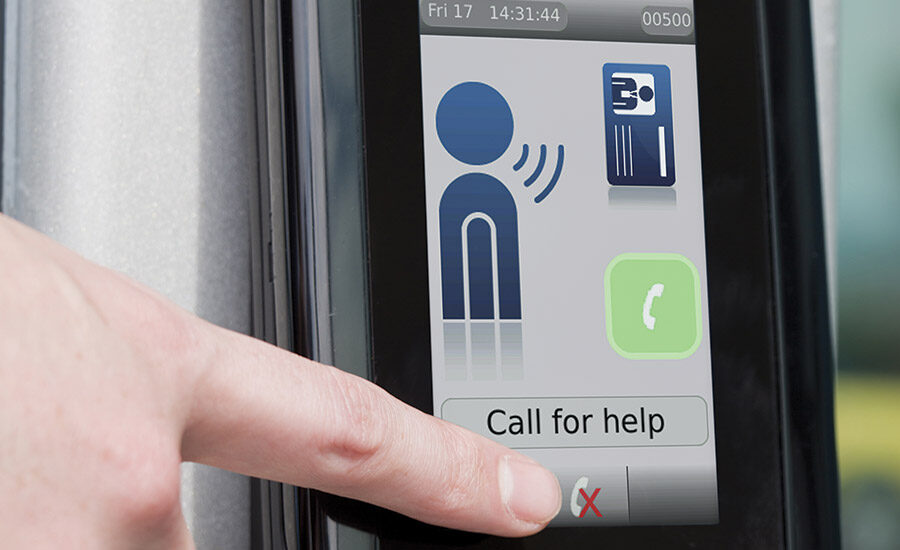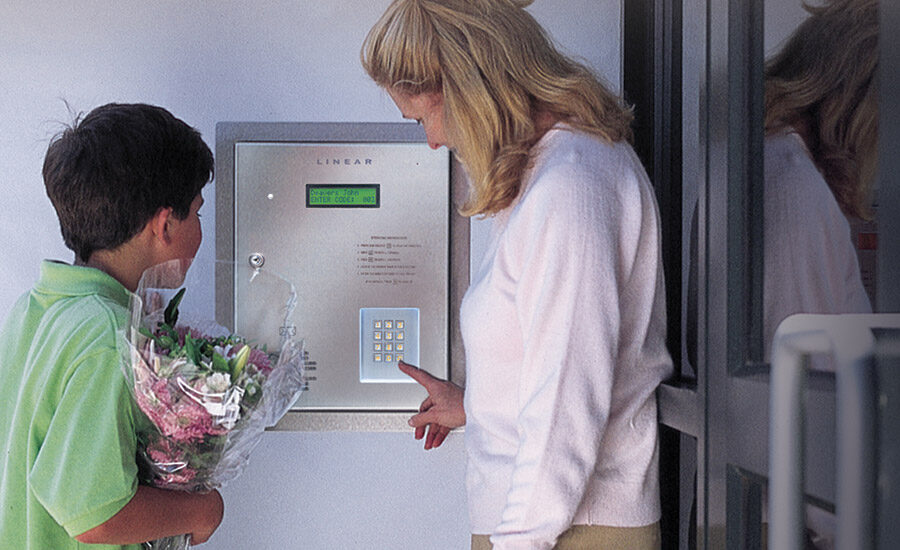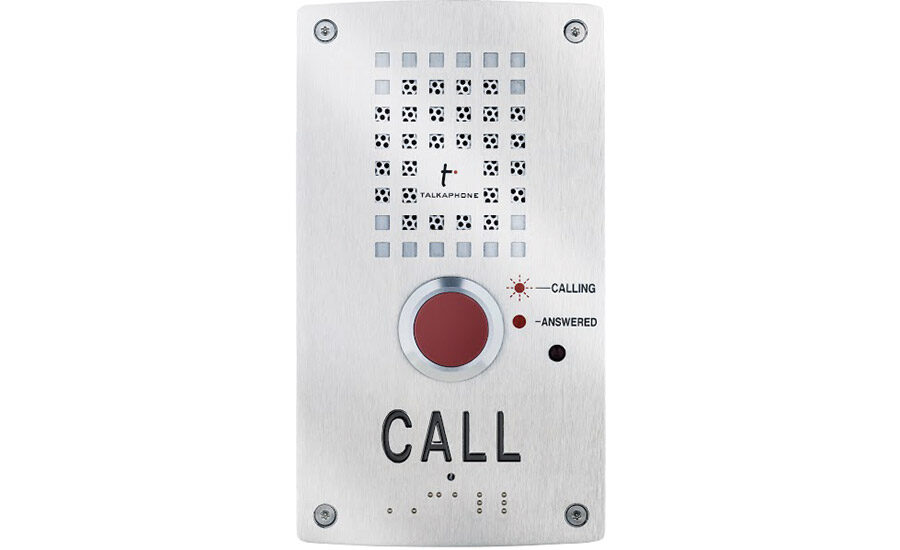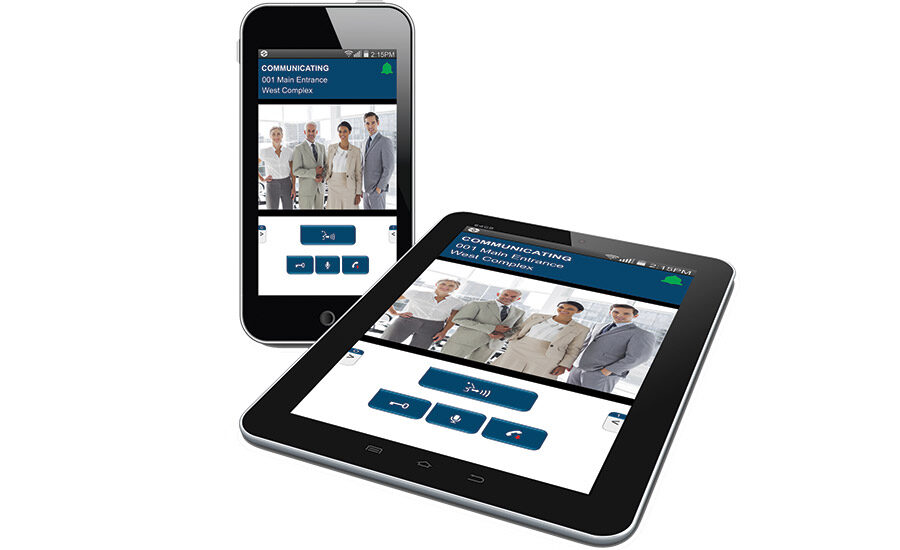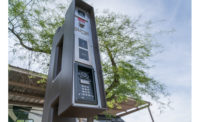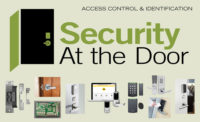Many telephone entry and intercom manufacturers have been in the business a long time — 80 years in one case — and for most of that time the technology hasn’t changed a lot: standalone units operating over plain old telephone service (POTS). But in recent years, the rise of IP and cellular technologies (along with the sunset of POTS) and the desire for more integrated approaches to security have changed things rapidly in this space.
“The technology itself has been around for a gazillion years,” says Richard Sedivy, director of marketing, DoorKing Inc., Inglewood, Calif. “Telephone entry systems in their simplest form are nothing but auto dialers. But today we are way beyond that in the functions that these things do and we are not having any trouble selling that. We put in very complex systems now.”
The audio component of door control has indeed become the true “third leg” of the access control/video piece, adds Peter Sandin, northeast regional sales manager, Stentofon by the Zenitel Group, Kansas City, Mo. Whether it is an intercom that goes to a single decision-making point or a telephone entry that allows individual users to grant access, being able to see, hear and control entry is now an expectation.
The advent of IP connectivity has moved telephone entry and intercoms from more of a standalone device to one that can and does work in harmony with the other traditional security technologies around the door, adds John LaFond, vice president of integrated systems, Nortek Security and Control LLC, Carlsbad, Calif. “The market has evolved. I like to use the term ‘pre-screening.’ More commercial and industrial applications have requirements for the pre-screening aspects of their security. Both intercoms and telephone entry are two subsets of the market that have traditionally been analog products, but are today moving rapidly towards VoIP (voice over Internet protocol) and mobile solutions.”
Rick Focke, senior product manager, Tyco Security Products, Westford, Mass., says from that from his standpoint as an access control manufacturer, requests to integrate to intercom products have skyrocketed in the past few years. “It is more popular than it was five years ago. We are seeing more interest in intercoms. We are being asked by the intercom companies, and they are being pushed by their end users.”
Maybe one reason is that the telephone companies have stated that the end is near for copper lines, prompting anyone that is looking ahead to consider one of the two main newer communications methods: IP and cellular. But regardless of which one they choose, the options for integrating and features are much greater.
VoIP & SIP
For someone walking up to the door, intercoms and telephones may look the same as always, but internally there are more options than ever before for connections, Sandin explains. “With session initiating protocol (SIP) and VoIP technology coming from the telephony world, anything not standard to a manufacturer can become a third-party appliance. That is where the change is happening.”
Using the audio SIP protocol it is possible to take an intercom product and interface it directly with the user’s VoIP system. Sandin sees a lot of POTS line scenarios going IP and Ethernet today because that ability to be a third party add-on gives the user many more features and functions above and beyond just an intercom call.
“Your VoIP system is made more robust by adding and integrating an intercom system, which is pushing the integrator to do more IP than ever. IP-based intercoms can do noise cancellation, volume adjustment, relays across the network — a lot of functions and features that in the past you had to run a hard wire for.”
Talk-A-Phone Co., Niles, Ill., makes both analog and VoIP-based phone products, says Samuel Shanes, chairman/CEO. “We have been making VoIP for at least seven years now. We still sell a lot of analog. But what is the future? The future is IP. Today’s integrators are well aware of IP and SIP is a basic, wide-ranging protocol for audio.”
SIP compliance is something that if an integrator is not already familiar with it, they should be, says John Mosebar, vice president of marketing, Aiphone Corp., Bellevue, Wash. “The trend right now is for intercom manufacturers like ourselves to have SIP compliance,” he says. “This allows you to tie into an IP telephone.”
LaFond adds that IP has benefits for the integrator beyond just features. “Quite honestly, most integrators are familiar with technologies that drop on the network as opposed to running over a copper line. VoIP technology today allows you to get open source products and lower cost technologies that can save a lot of money. Not only does the expense of the copper line go away, but it gives the integrator the capabilities to provide remote services and evolve into a portfolio that allows them to enjoy an RMR.
“Where we are evolving is no longer as a device on the edge. Now it is about ‘how do I get to you?’ If someone rings a doorbell at one facility and I am at another facility, connectivity is critical. Now with the cloud there is a whole host of services that can integrate single-point or multi-point technologies,” he describes.
Cellular
Another logical communication path, especially for telephone entry, is cellular. While it is not as common yet as VoIP, at least one manufacturer is banking on this method as a trending alternative to VoIP or POTS.
“We have had tremendous interest in cellular devices by integrators for several reasons,” DoorKing’s Sedivy says. “Number one, the installation is greatly simplified. They don’t have to worry about copper lines or Ethernet cables. They simply connect the cellular device to the phone system, register it and they are up and running.”
Unlike SIP where the intercom or phone becomes a third-party add-on, with this method, the entry system essentially becomes a stationary cellular phone. While there is a monthly fee, just as there would be with a cell phone, it is comparable to VoIP and POTS, Sedivy says — particularly when you add in the cost of pulling cable or paying for long-distance service on POTS lines, because with the ubiquity of cell phones today area codes are meaningless.
The more difficult road for the cellular method is comparing the ease of programming, particularly versus VoIP, which uses Internet cabling. POTS uses modems, which are becoming obsolete quickly. At the moment, DoorKing’s cellular product only works through AT&T service, Sedivy explains.
“We provide a service that offers both voice communication, which is the simple part, but also programming services. We can push data from the computer down to the telephone entry system,” he describes.
This is particularly important in a commercial or industrial system that might have hundreds or thousands of people, time zones, security and permission levels, Sedivy says, but is not easily done by cellular means. “Your cell phone can easily go out and request data from the Internet, but asking for data to come down to your system is harder. You can’t have a program on the computer to send information directly to the cellular system. So we have worked with AT&T to develop that capability.”
So far the other carriers haven’t figured out how to do it yet, but when they do, DoorKing will add that capability, he says. And when that happens, “cellular is going to become extremely popular,” he adds.
Others are less sure. While they do have cellular connectivity as an option, LaFond says people are not jumping on board with cellular just yet. “It is the cost of cellular that people don’t want to incur, especially when VoIP is one-eighth of the cost. But I can guarantee that cellular is a component of our roadmap, particularly for applications where you can’t get lines. I truly believe that as the network is more and more accessible, cellular will not be the choice. But I do believe that cellular phones will be a component of the experience.” (See “The Mobile Effect” on page 80.)
Pulling It All Together
Telephone entry and intercoms today are made to work in concert with other elements of a security system — as that third leg of the stool along with visual verification and physical control.
“This is our 80th year in business,” Shanes says. “We come out of the intercom world and access by intercom is a basic kind of product that served a need and a function. What has happened is access control [and security] has become very professionalized. The communications piece is no longer stand alone, but an element of the total security system.”
Talk-A-Phone and others now offer units that include access and video all in one unit, Shanes says. “We brought out a line specifically designed for access situations, which is smaller and more distinguished looking, with or without IP cameras. These are native IP/SIP devices that will connect and work with IP cameras and operate with the VMS. We have found they really meet the needs of a professional installer that has to show what value he brings to the equation. Often these units are at the front door and the first chance to make an impression. They also provide the ability for the integrator to shine and promote their expertise.”
Aiphone, too, has integrated video cameras to allow a single footprint at the door, Mosebar says. “If you think about the entry point, it was traditionally a standalone reader and maybe a surveillance camera looking at that area. If you had intercom or audio, that was another piece at the door. We now provide the communications, the buzzer, offer a card reader as an option, and of course the video camera all in a nice, inexpensive single package. And having an intercom in that same enclosure offers a unique solution. On an intercom head-end station it will provide an exact location where pre-programmed or identified to know instantly where this caller is coming from.”
Indeed, because of the improved audio capabilities and control that comes with VoIP and SIP, intercoms themselves can be turned into an emergency annunciator as well, Sandin says. “It goes above and beyond a call point. It allows the ability to use the intercom throughout the facility to make announcements or evacuate a building or move people to a muster zone.”
On the flip side, access control and video manufacturers, in addition to providing integration to telephone entry and intercom manufacturers for their more sophisticated systems, are also getting involved in this smaller to medium corporate market with options of their own.
In Tyco’s case, its CEM Systems division offers the Emerald product, which integrates a reader and user interface that allows the user to push to talk to a guard or officer using the IP network, Focke says. “It really marries both worlds together — access control and intercom. It also saves a lot of cost if you don’t have to run a separate CAT 5 cable for an intercom system. It won’t take the place of the more sophisticated systems, but if the customer just wants more basic intercom functionality, this is a nice choice.”
Tyco’s Kantech division also has an entry system aimed at small commercial, residential or multi-tenant, he adds. “What is nice as part of the Kantech system is visitors can still find the tenant to get buzzed in, but it is not two separate systems to keep synchronized.”
In fact, LaFond sees a true convergence happening within the intercom/telephone entry industry, not only between those two technologies and other security systems, but also with visitor management systems. “They are all moving together, merging at different layers.”
Hunter Fort, national business development manager for camera manufacturer Mobotix, New York, says that side of the security business is a natural to add the audio portion for an all-in-one solution.
“We are a camera manufacturer but we also have a door/intercom entry product. Any camera can become an entry intercom using VoIP/SIP. We find that technology specifically related to VoIP is driving the intercom market more than it has in the past and has become truly converged with video. I would say that, in itself, is truly pushing the envelope of door entry as opposed to traditional POTS or non-video enabled intercoms.” n
Advice for Integrators
By now most integrators are familiar with IP protocols and probably even cellular, but when it comes to the audio component there are things to be aware of, say the experts.
Communication and programming are two big ones, explains Richard Sedivy of DoorKing. “How am I going to communicate with this thing and how am I going to program it? The communication part is simple; it is the programming that can get more difficult. If you are going to use POTS lines, fine. But be aware, the sunset is coming on POTS lines.”
VoIP is a method that makes programming easy because of the Internet connection, but there may be trade-offs in terms of distance capabilities, he says. With cellular you don’t need to wire anywhere, but you may not be able to program it as easily.
The advent of VoIP has meant that intercoms and telephone entry systems are more often than not part of an integrated entry system, says Samuel Shanes of Talk-A-Phone. Integrators incorporating one of these entry control products into an existing access control or video system need to understand the capabilities and flexibilities of both systems, he says. “Is it going to work with a certain VMS system? Make sure that the manufacturer has done the development to work with a variety of different platforms.”
Rick Focke of Tyco Security Products, agrees. “If you want integration into the access system, do the homework up front and make sure that specific model works with the access system, whether that is Software House or a different brand. Sometimes that does drive the choice of the intercom system. If you have an established access system, that is the starting point. Then, as far as feature sets, make sure the intercom system can give you the functions you want for map call-ups, voice-to-the-workstation, direct VoIP, etc.”
Because there are more features than there used to be, it is important to understand which ones the user wants, adds Hunter Fort of Mobotix. “My advice to anyone working with an end user to install a door intercom solution would be to truly think about the use case. How and who will be accepting those calls? If you consider the how and who prior to selling the solution, it may dictate which product you use; and in the case of the industrial or commercial user, do you need to involve VoIP? Keep it with the IT department or with security? As an integrator, if you do not look at the desired end result you will have issues.”
And perhaps most importantly, he adds, is make sure you truly understand VoIP, not just the IP portion. “By default most integrators understand IP and programming, but in many cases they don’t understand VoIP. It is two separate protocols. They need to understand SIP. In my experience traditional security integrators are not VoIP phone integrators. This is a convergence of technology that you have to understand or you won’t be able to make it work.”
The Mobile Effect
Any discussion of communication by phone, cell or VoIP line would be incomplete without discussing the impact of mobile phones and devices, which are becoming de facto in society and security alike. In other areas of the security world the mobile device is being considered as a reader, a credential and/or a control device. How will it affect the intercom and telephone entry portion of security?
“We will always have that box, in my opinion,” says Richard Sedivy of DoorKing. In the case of telephone entry, which is used for people who don’t have a credential, such as visitors, there is currently no substitute for pushing a button to talk to a live person, he says.
But this technology may advance quickly. There are already several manufacturers that offer mobile capabilities such as remotely opening gates or doors from an app.
“We have a browser-based embedded utility within our hardware, says Nortek Security and Control’s John LaFond. “We can mount gear on the network and remotely access it without loading hardware onto a computer. This is part of the evolution in this market segment — moving to embedded browser platforms or something in the cloud. You literally just connect into it through TCP/IP and you don’t need to load any software.”
The whole mobile trend is here to stay, says John Mosebar of Aiphone Corp. “It is here. It is trending higher. People are asking for it and we can’t overlook it. Future product developments will have to bring that functionality into anything new that we are developing.” Aiphone just introduced a product about six months ago that has this functionality, he says.
“The mobile phone can be an edge device that replaces a traditional hardware station on a desk or wall, or even in place of a computer screen. Currently our mobile functionality gives them basic features to respond to a call from a door. The call comes in, they can see the person, verify who they are, confirm and do something to allow or deny access.”
MORE ONLINE
For more on intercoms and entry controls, see these past articles in SDM.
